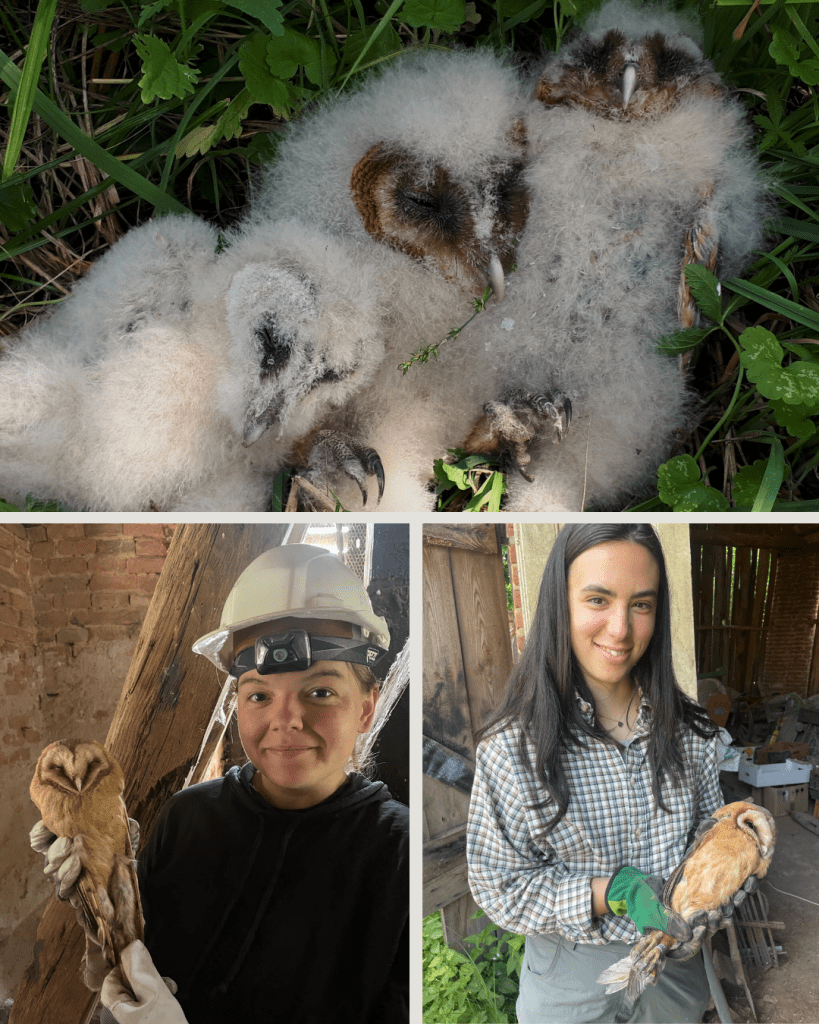Ambios has worked with the Barn Owl Foundation in Hungary for over two decades of Erasmus projects and cooperations, sending and receiving trainees. A close working partnership enabled us to link two recent Ambios trainees with the Foundation so they could explore an opportunity to go to Hungary and be involved in some fieldwork. Here’s a wonderful description of their visit. It you’re interested in exploring the Ambios network of European organisations involved in nature recovery, check out one of our UK training opportunities, where we can discuss ways to connect to our European partners and their amazing projects.
Every town and village we pass through has a church. Faded custard yellow walls, spires squat and curvaceous against June-blue skies. Inside, they are cool, airy. Jesus and Mary stand tall on their plinths, fingers pointing to flaming Sacred Hearts. Some chapels hold fresh flowers, in others the pews are dusty, perhaps the faithful are becoming fewer. Lines of scripture and frescoes decorate walls, the same scenes painted by different hands, one much better at depicting horses (or maybe camels??) than his counterparts. One church even contains a whispering wall, where, we are told, under the cover of holy water, couples would agree on their clandestine meeting places. Although we don’t stop at all of them, we joke about how we are becoming experts in Hungarian churches. These places of worship are perhaps an unexpected setting for a week spent volunteering for The Barn Owl Foundation, Hungary, and yet we quickly learn that here, the Barn owl is more accurately a Church owl, and whilst we visit dozens of churches, we only check three barns.
Established, like Romy and I, in 1997 (clearly a good year), The Barn Owl Foundation, Hungary (Gyöngybagolyvédelmi Alapítvány) has nest boxes for owls and kestrels scattered all over Zala County in western Hungary, all of which are monitored throughout the breeding season by Akós and his seemingly endless network of friends. We spend our days driving between the winding Mula River that marks the border with Slovenia and the glittering waters of the Kis-Balaton. The landscape is wide and, for two people used to the south Devon hills, flat. The fields are almost unimaginably huge, relics from Communist agriculture, but the areas of intact woodland match them in size. In between churches, we visit glorious meadows, teeming with the texture of myriad plant species, sandhills puckered with Bee-eater burrows, from which the birds themselves flicker like winged jewels, and wetlands, so full of herons and warblers, I almost didn’t know where to look. We check boxes in a fruit farm, a convent, a Water buffalo reserve, a hayloft above a cow byre, where we see our first toffee-brown adults flying quickly away from the box, and memorably a nest box made out of an old bedside table mounted at the apex of a barn full of other abandoned furniture. Every place we stopped, every box we checked had its own quirks, its own wonders and its own story to tell, so much so that to relate the experience of even just one week with Akós and the Foundation could fill a book.
In the wide meadows we would stop to check the boxes for Kestrels. Mounted just slightly too high for comfort at the top of an alarmingly skinny pole, these boxes required ingenuity and a head for heights. First, someone would creep as quietly as possible up to the box carrying a long stick with a large tupperware lid screwed to the top, which would be used to block the entrance hole of the nest (easier said than done). Then the relief team would scurry in with the ladder, and, after a little bit of manoeuvring Chuckle Brothers style (to me/to you), we would be ready to investigate the nest. Climbing a swaying ladder and extracting irritable raptor chicks with sharp beaks and sharper talons to shove them unceremoniously into a drawstring bag is a skill I never knew I had. Once on the ground, though, tenderness takes over. Each chick is lifted from the bag, and held firmly but with care whilst one of the team fits the rings around its tarsals. Silver on one leg, red plastic on the other. The chicks, however, remain unimpressed, screaming blue murder at the tops of their tiny lungs. Then, when the whole brood is rocking their new bling, its back up the wobbling ladder, bag in hand, and the entire process is repeated in reverse.
Hatty Wigginton




